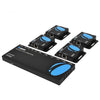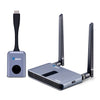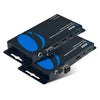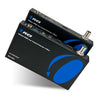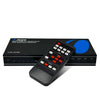What Is HDMI Over Ethernet and How Does it Work?
What Is HDMI Over Ethernet and How Does it Work?
You may have used an HDMI cable before, but have you ever heard of HDMI Over Ethernet?
To start, let’s define both. An HDMI (High-Definition Multimedia Interface) cable is the most optimal way of transmitting digital video and audio data from input devices, such as cable boxes and consoles, to output sources, such as your 4K TVs and monitors. HDMI cables make for an excellent tool to stream from one device to another.
On the other hand, Ethernet is a traditional technology used for connecting devices in a wired Local Area Network (LAN) or a Wired Area Network (WAN). An Ethernet cable is comprised of networking technology that includes the likes of a protocol, a port, a cable, and a computer chip needed for plugging a desktop or a laptop into a LAN for quick data transmission through its coaxial or fiber optic cables.
Using an Ethernet cable is best for connecting multiple devices. You can use this for formatting and transmitting data to a network of desktops, laptops, and other devices which are in the same LAN.
Some benefits of using Ethernet cables as opposed to using Wireless LAN (WLAN) are:
- Ethernet cables provide less vulnerability to interruptions and degradation because of the stability that a wired connection offers; and
- It provides a safer and more secure way of data transfer because of its physical attribute. The wired connection of devices makes them less likely to be accessed by potential remote hackers.
Going back, these technological advancements have led us to combine both HDMI and Ethernet into one useful tool: HDMI Over Ethernet.
First off, what is HDMI Over Ethernet?
HDMI Over Ethernet, also referred to as HDMI Over IP, is an extensive combination of the two mentioned technologies. It uses an existing infrastructure’s Ethernet connection to disperse and distribute high-definition video signals from one source to single or multiple output screens. What’s better is that you can send HD signals to distances of up to 230 feet.
For a better understanding, imagine an office with multiple desktops. When you have an HDMI Over Ethernet connection, you can project one screen to all connected devices. You can also use this to display your presentations over a digital projector.
For your home setup, you can use an HDMI Over Ethernet to stream HD shows from your input device to your television.
This type of setup has a lot more uses and advantages either from point-to-point extensions or from one-to-many distributions. You can also use it for video wall processing which can be scaled from different grid layouts. Video signals are flexible and can be switched from any source to any screen and are highly capable of overcoming distance limitations brought by regular HDMI cables.
So, why do you need HDMI Over Ethernet?
- Long-Distance & Multiple Display Outputs
The technology uses your Ethernet’s Fiber Optic cables to transmit compressed video and audio data. Through this, you can send signals to multiple devices over long distances without any noticeable drop in resolution. However, it’s important to note that the highest possible resolution that you can send and receive depends on your devices and the type of HDMI Extender.
- Connection Stability
Since HDMI Over Ethernet utilizes fiber optics, it is less prone to electromagnetic interference caused by high-voltage appliances. This is especially important when applied to a workplace setup where there are multiple high-powered devices such as heating and cooling systems.
- Convenience
With an existing Ethernet system in place, you won’t have the need to run new lines of cables just so you can do what you have to do with your HDMI Over Ethernet system. Also, this technology allows for less clutter and more hassle-free use of your devices.
Basically speaking, it is a more convenient, fast, and clutter-free way of optimizing your TV/monitor to use and show what you want it to be used for and what it should show in the comfort of your own space.
How to set it up
For starters, you need a few items to extend HDMI over Ethernet. Here’s what you need:
- Input device
Your input device could be your computer or laptop. This is what you’ll use to transfer signals to your other devices.
- Output device
The output devices could be a laptop, a digital projector, or a video wall. Your output devices are where you want to send your audio and video signals.
- Ethernet structure
For areas with an existing Ethernet structure, this won’t be a problem. If you don’t have an existing cabling system, you might want to plan it carefully so you won’t have any issues during your implementation.
- HDMI Extender Over CAT6/7 Cables
Your HDMI Extender is what powers this whole setup. However, before you buy the best HDMI over Ethernet extender you can find, it’s important to consider these factors:
- Device Resolution
Having an 8K HDMI Over Ethernet extender isn’t always necessary. Check your input and output device’s highest resolution setting and simply match it. If you have 4K monitors, then getting a 4K HDMI over Ethernet extender is the only thing you’ll need.
- Distance
There are HDMI Extenders that support up to 230 feet, and some that can only best support up to 110 feet. Measure the distance your ethernet cable has to run so you don’t have to overspend on your HDMI Extender. You should also know that distance affects the quality. The same HDMI Extender that streams 4k/60Hz at 115 feet can only stream 1080p/60Hz at 165 feet.
To use your HDMI Over Ethernet setup, you may follow these steps.
- Place your input and output devices in their respective locations.
- Set up your ethernet cable so it connects neatly from one end to another. Make sure your ethernet’s fiber optic cable is well protected in case you have to run it across halls or areas with foot traffic.
- Connect your HDMI Extender’s transmitter to the end of your ethernet cable where your input device is located and connect its receiver to the opposite side of your cable.
- Connect your devices to their respective ends of the HDMI Extenders.
- For unpowered ethernet cables, you may have to connect either your transmitter or receiver to a power source. Check your HDMI Extender’s manual to know which end you should plug in and what type of power cable you might need.
Once you complete these steps, you’re done! In case this setup doesn’t work for you, you may have to follow some available troubleshooting tips online. These may include inspecting your ethernet cable, HDMI cable, and power cable, all the way to checking if your device’s ports are working properly.
For the best HDMI over Ethernet latency, make sure your fiber optic cable is functioning properly. In the best cases, you can use HDMI Over Ethernet for gaming, streaming, or other activities that require minimal to zero latency.
One last tip, make sure you get your HDMI Extenders from credible shops like OREI. These items are not cheap and it’s best to get yours from established brands. Visit our shop today to check out our list of HDMI Extenders. You can check out some sample applications, technical information, and customer reviews of all our products so you can have all the details you’ll need to make an informed purchase.
Learn more about HDMI devices by reading more of our available articles in our blog!


